#r.o.d. the tv
Text

230 notes
·
View notes
Video
Twitter was asking for anime scenes that stay rent free in your mind and now I’m posting it here too on the off-chance I can convince more people to watch Read or Die the TV, a show that rewrote my brain chemistry back in the day
#i've had a lot of ships over the years but nenene and maggie will always be special to me#they were the blueprint#read or die#read or die the tv#r.o.d. the tv#nenene sumiregawa#maggie mui#michelle cheung
61 notes
·
View notes
Text


"Don't let go of my hand. No matter what happens"
4 notes
·
View notes
Text
youtube
THE PILE PRESENTS: X-Play - Serpent Muncher | 11/17/04
What a thrill, indeed.
(Original G4ZDTechTV Air Date - May 26, 2017)
(4GTV - STREAM WHAT YOU PLAY! WATCH NOW!)
#The Pile#G4TechTV#X-Play#Metal Gear Solid 3#Metal Gear Solid 2#Metal Gear Solid#Metal Gear Acid#Ape Escape 3#Boktai: The Sun is In Your Hand#Bad Boys: Miami Takedown#Office Space#anime unleashed#R.O.D. the TV#Gungrave (anime)#Circuit City#Cinematech#Fight Club (video game)#Best Buy#Sony#Spider-Man 2 (video game)#Domino's Pizza#The Incredibles (game)#Killzone#Samsung#Panasonic#Need for Speed Underground 2#The SpongeBob SquarePants Movie#TOYOTA#Donkey Kong Country 2: Diddy's Kong Quest
2 notes
·
View notes
Text
Hello, all!
Thanks for checking out my page. I’m an avid reader and caffeine fueled ADHDer. I write fanfics for SwanQueen, Bering & Wells, SuperCorp, and many others. If you’d like to check out my work, I’m Harleychick91 on AO3 and FFN. So my page is full of book recommendations, fanfiction, and other ship related posts. Feel free to follow if that’s your thing!
If there’s a story you can’t get out or your head, I’m always open to fic requests. Send me a message if you’d like to brainstorm. I always give idea credit.
Thanks!
I’m slowly working on playlists for my top ships.
SuperCorp: https://open.spotify.com/playlist/4H7N2mSASybjX9t0lO6YiW?si=louZbePYSDKWOdyG4w3JUQ&pi=u-ucaJsMivRma4
SwanQueen:
Bering and Wells:
#supergirl#supercorp#bering and wells#warehouse 13#swan queen#once upon a time#ouat#wh13#swen#ao3 fanfic#fanfiction#teriah#the young and the restless#oitnb#resident evil#korrasami#rizzoli and isles#rizzles#law and order svu#wlw#writers of tumblr#women loving women#les friction#lesfic#legend of korra#orange is the new black#r.o.d. the tv#read or die#Spotify
5 notes
·
View notes
Text
Zaphod and the ghost of his grandfather

Recently, I was reading my handy The Ultimate Hitchhiker's Guide, which brings together five novels and one story [1] by Douglas Adams. While going through the second book, The Restaurant at the End of the Universe, I came across a scene where Zaphod Beeblebrox, the figurehead president of the galaxy, talks to one of his ancestors! The fandom page for the book mentions this in one line, saying "Luckily, an ancestor of Zaphod's, Zaphod Beeblebrox IV, saves them." There's a lot more going on than that one line in this story, which I'll explain in this post. I wish this scene had been in the movie, but alas, it is still great to have in the book.
Reprinted from my Genealogy in Popular Culture WordPress blog. Originally published on September 14, 2020.
As the Vogan fleet approaches the Heart of Gold, Zaphod makes a gamble and talks to his deceased relative, his great-grandfather. [2] He thinks that his ancestor can help him, and he begins trying to summon him, concentrating, even as his fellow crew members doubt this will work. It is finally successful, but his ancestor is pissed at him for not sending flowers and respecting him, saying he is disappointed in him. He pleads for his great granddad to help him, even as he is reprimanded for not caring about his ancestors and more about himself. He drops all pleasantries and decides to confront his ghost-of-an-ancestor, who even slows downtime for him. He agrees to help them because he doesn't want him and his "modern friends" slouching around. However, he states that if he ever needs help again, he should not "hesitate to get lost." The ship speeds away through space, and, as shown at the beginning of the next chapter, the Vogans believe they have destroyed the Heart of Gold.
Reading this, there wasn't as much of a family history focus as I would have thought. I would like to mention the occasional family history themes in a Mexican-American animated series named Victor & Valentino and in Cleopatra in Space, specifically in the character of Medjed, whose ancestors were moved from Ancient Egypt to a faraway star. [3] I am excited for the next season of Carmen Sandiego, which will undoubtedly focus, at least in part, on Carmen trying to find her mom, engaging in a family history journey of sorts, building on what has happened in previous seasons. There are also some family history themes in R.O.D. the TV, although no one investigates the family roots of any of the characters. Otherwise, I have draft posts about The Godfather: Part II, Outlander, and characters in the comic book realm, which I'll try to write up sometime this year. As always, I look forward to your comments and suggestions about my next topics to write about.
© 2020-2023 Burkely Hermann. All rights reserved.
Notes
[1] The five novels are The Hitchhiker's Guide to the Galaxy; The Restaurant at the End of Universe; Life, the Universe and Everything; So Long, and Thanks for All the Fish; and Mostly Harmless. The one-story is Young Zaphod Plays It Safe.
[2] See chapter 3, or pages 159-166 of The Ultimate Hitchhiker's Guide.
[3] There are also, as I've noted on this blog, family trees/diagrams in Futurama, Amphibia, The Simpsons, and Infinity Train, Gore Vidal lampooning genealogy, roots work in Little Fockers, and family history themes in Steven Universe and She-Ra and the Princesses of Power. In a recent post, I noted the focus on families in The Owl House, 3Below, Mysticons, Twelve Forever, and Human Kind Of, with startling family discoveries in Roswell Conspiracies: Aliens, Myths and Legends, Kipo and the Age of Wonderbeasts, Sherwood, Adventure Time, OK K.O.: Let's Be Heroes!, Final Space, and Mr. Robot, and Cleopatra "Cleo" in Cleopatra in Space and "Jack" in Samurai Jack missing their families as they have both been flung far into the future. I also pointed to those who noted family trees in shows like Bewitched, Donald Duck, Lord of the Rings, and several other awful shows/franchises.
#grandfathers#hitchhikers guide#the hitchhiker's guide to the galaxy#cleopatra in space#victor and valentino#carmen sandiego#zaphod beeblebrox#r.o.d. the tv#read or die#the godfather#outlander
4 notes
·
View notes
Text
A scary intergalactic "library" in Megas XLR

Kiva finds out that the space station is an "archive world."
Scary libraries are so common in popular culture, that TV Tropes even has a page for it, more ingrained than elderly patrons or librarians, as shown in various animated series. [1] That site lists three animated series as having spooky silent library: an episode of Arthur, the episode "The Library" of Avatar: The Last Airbender, and the "Buggin' The System" episode of Megas XLR, the fifth episode of that animated series. Since the Avatar episode is focused on elsewhere in this blog, as are episodes of Arthur, I'd like to focus on Megas XLR in this post.
Coop, one of the show's protagonists, crashes their giant robot ship (Megas) in a ring world after going through a minefield. Jamie gets scared of what is around them while Kiva says that based on the structure and alloys used, it was built by a "highly advanced race." They fall into another level of the complex, activating the Ringworld. Kiva calls it an "archive world" which could have information on "every species in the universe" with Jamie adding it is an "interstellar library with some wicked bookworms," referring to the worms which attacked them. The whole rest of the episode, the worms attack them, as they try to defend themselves.
When they think they'll get some usable information out of the world and after the worms are defeated, Coop ends up knocking down all the "towers of knowledge," making them unusable to them. He laments that he always had "bad luck" with libraries, hearkening back to an earlier part of the episode where he tried to grab a book at a higher shelf of the library, causing all the bookcases to fall over and crash into each other like dominoes. He then says that the knowledge of the universe is now lost forever and Kiva reminds him to avoid the mindfield. The episode ends, with the library never to be seen again! This reminds me a lot of R.O.D. the TV, where a pile of books was burned by the British Library, which I described in my review of the series and how it relates to the plot as a whole:
...we find out why Anita doesn't like books: they remind her of painful memories, like the burning of books and a shadowy figure standing nearby...They then find out about the awful plans of the British Library to steal all the books in the area, putting them in a huge pile. The citizenry is alarmed and the books burn in a huge fire. These villains are some of the worst! Awful to burn all those good books! Yomiko tells them to stop and put out the fire, asking them how they could do such an evil thing, with Wendy telling it is a "bit like last time," referring to the previous fire at the British Library. Anita has a flashback to the burning of books which traumatized her earlier in her life, and Wendy declares that Yomiko will "pay for" what she did...It reveals that Yomiko got out of control for how they were treating Junior, and Nancy by extension, leading the library to be destroyed with paper, then unintentionally starting a fire, burning hundreds, if not thousands, of books in the British Library itself. Anita is totally freaked out when she sees the hologram, especially of herself watching the fire burn, implying she has some connection to the British Library itself!
For one there is the problematic archives/library confusion, just as series like Star Wars, Mystic Archives of Dantalian, The Bravest Knight, and comics like Lore Olympus, That Awkward Magic!!, have done. Secondly, the facility is more like a data center than a library or archive, and is just a bunch of data towers. So, its imposing, there are no librarians present, and it is generally terrifying, to say the least! I don't really have anything good to say about this as a form of library, and librarian, representation. Not at all.
© 2021 Burkely Hermann. All rights reserved.
Notes
[1] In Soylent Green, the main patrons are other old people, probably also considered "books", one of whom does a good job summarizing the technical information and says the truth about Soylent Green needs to be revealed. Another good example of an elderly patron is Matilda "Tildy" Pilqvist in Hilda. She is a powerful witch and had a book titled "The Skeleton Whispererer" which was checked out for almost 30 years as shown in the episode "The Witch." She was the mentor of Kaisa, the librarian at the local Trolberg city library, and comforts her after she admits she cannot do a spell, saying she is pleasantly surprised to see her as a librarian. What a nice elderly patron indeed! On the other hand, there are elderly librarians, like the one shown in Prisoner Zero. In the episodes "Ragnabook: Part One" and "Ragnabook: Part Two," a monster ravages the library and threatens to steal all the knowledge within its walls. Luckily, it is stopped but in the process, the blue-skinned librarian loses his memory (in the last of those two episodes), despite efforts by Zero to get him to remember the past.
Reprinted from Pop Culture Library Review and Wayback Machine
4 notes
·
View notes
Text
12 Days of Christmas Anime, Day 12: R.O.D the TV’s Slow, Strange Christmas Miracle

The Christmas episode of R.O.D the TV centers on a classic Christmas miracle, where a little orphan girl on the verge of freezing and starving is adopted into a loving home just in time. For added Yuletide appeal, the entire drama plays out beneath the loving gaze of Mother Mary and Baby Jesus in an abandoned Catholic church, because nothing says Christmas like chiaroscuro and statues. But here’s the thing: this Christmas miracle didn’t have to play out just in time. It could have happened a day earlier, saving the little girl, Anita, from a frightening night spent wracked with hunger and in the depths of despair. But the delay to Anita’s miracle—the miracle that sees the Paper Sisters come together and forge the found family that carries this series—reveals something profound to us about the nature of the miraculous, which is at once both supernatural and natural, both wonderful and weird.

It’s a cozy Christmas Eve under the kotatsu, as the Paper Sisters and their friend Nenene celebrate the season with…a birthday cake? That’s right, it’s the sisters’ birthday! Not their literal day of entry into the world—that would be too big a coincidence even for anime—but rather the anniversary of the day that they were reborn as sisters. So settle in for story time, because this calls for a flashback!
~~~~
It was a dark and stormy night. Michelle and Maggie, both workaday Paper Masters for hire, cross paths in a client’s dingy warehouse basement and hit it off straight away over a shared passion for a book about a giraffe with a short neck. They’ve been hired to check out a hidden cache of rare books, secreted away beneath a church somewhere in the wilds of Hong Kong. Once on-site, as they rummage through the suspiciously undusty tomes—the books are fakes, a mere McGuffin to bring the MCs together—a little voice pipes up: “If you’re Santas, then give me a present, and if you’re thieves, then let me join you.”

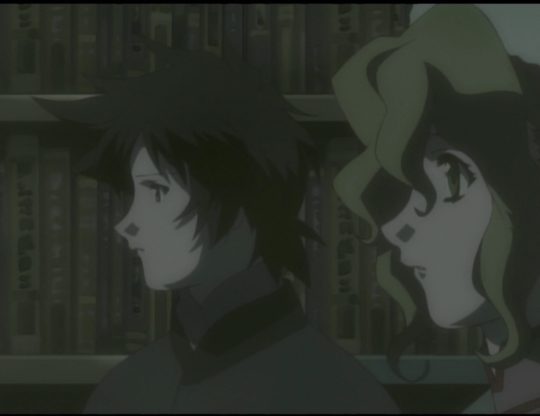
The voice belongs to Anita, who proceeds to mumble an account of her sad life story: her orphanhood, her inability to find food, her increasing desperation, and finally, her prayer to God for a miracle. “It’s Christmas Eve, right?” she explains, “So I was praying. Then I heard your voices.” Are Michelle and Maggie the answer to Anita’s prayer? She seems to think so: “God must have brought you to me.” But they aren’t ready to jump to any such conclusions. They certainly aren’t Santas, and they’re not exactly thieves either, but of the two, they’re closer to being thieves, as they admit. And so they dodge little Anita’s question, claiming that she’d have no future with them. They leave the girl to fend for herself as they go their separate ways, never to meet again. They don’t even offer to buy the girl a meal.
What a desultory Christmas Eve. Alone in the empty, cold church, Anita curses God. Her prayer was useless.

Poor Little Paper Girl…
Or was it? After all, miracles are supernatural, it’s true, but they also have a natural element to them. God chooses to partner with people to do the impossible. And so sometimes, miracles need a little time to take root in the hearts of those who must help bring them about.
As Maggie wanders along streets alight with decorations and jolly with celebrating couples and families, she lifts up her drooping head (her head is perpetually drooping, possibly in an attempt to appear not quite so tall) and glances to the side, where she catches sight of her reflection melding with that of a statue of Mary and the baby Jesus. It’s a moment of realization for the lonesome gentle giant—recognition of the family that could be, perhaps.
Meanwhile, Michelle finishes reading the book that had fleetingly bonded her and Maggie, The Story of the Giraffe with the Shrunken Neck, and stares into the mid-distance. Is she recalling that moment of shared bibliophilic delight and the friendship it seemed to portend? In the let-down of the failed mission, Michelle and Maggie’s shared sympathy was overshadowed, too fleeting a thing to keep them connected. Like Maggie, Michelle is struck by a sudden understanding, though there’s no indication of what it might be.


Until the next morning, that is, because Michelle is a woman of action. When she returns to the church bearing a gift for Anita, the girl is despairing of hope and humanity and bemoaning her empty stomach, enunciating cynical remarks about Christmas Day. She is in no mood for Michelle’s offering of the giraffe book, partly because, as she points out, a good story won’t fill her stomach. But more so because, as earlier episodes revealed, Anita has a deep-seated loathing of books due to childhood trauma (insert series-long dorama arc). But no sooner does the complaint leave Anita’s lips than she finds herself in a warm embrace, with reassuring words from Michelle, “I can do something about that,” and an offer of a home to call her own. This is followed shortly by another gift, as this time Maggie darkens the doorway with that same book in hand and her heart ready to make room for the little girl. When Anita adds to her physical complaints (classic tsundere), pointing out that “a good story won’t warm my body,” Maggie unwittingly echoes Michelle’s words, “I can do something about that,” wrapping her scarf around the little girl as proof. And with that, beneath the indulgent gaze of Mother Mary holding Baby Jesus, the three decide to become sisters. Christmas miracle achieved.

There are two key things about this story. The first is that the miracle here takes time. The two young women do not abandon their solitary lives right away. They are professional working women, after all, and taking on an orphan all alone (as each expects to be doing) is a big commitment, whether it is for life or just until they find the kid some proper help. And so in the moment, when faced with Anita and her desperate need, their instinct is to return to their usual routines and ponder awhile. They consider the implications. And then they act.
In the meantime, Anita is left unaware of what all is going on in the hearts and minds of her soon-to-be saviors, and she succumbs to anger and despair. Miracles can take time. That’s part of it. But there’s a beautiful picture of grace here as well: God had already put into motion Anita’s miracle, the answer to her prayer, and he did not interrupt or abandon it when she became ornery and impatient (i.e., her usual self!). He kept working on the hearts of Michelle and Maggie, even as Anita cursed him. He gives good gifts, regardless of whether or not we are gracious recipients.
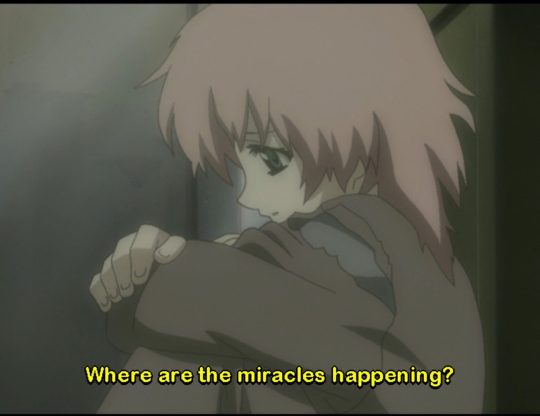
There’s more too. Anita herself actually takes a long time to fully receive her Christmas miracle. Yes, the three become the famed Paper Sisters from that moment on, but they’re not yet truly sisters. On Christmas Day, Anita doesn’t admit to Michelle and Maggie that she hates and fears books; to do so would be to bare her own broken heart, and she needs time to learn to trust them first. For now, she misdirects them with the complaints about her physical needs, avoiding the issue of her emotional wounding. Opening up to Mi-nee and Ma-nee will come later—and in fact, it takes the rest of the series (providing it with its core emotional arc). In other words, the fullness of the Paper Sisters’ Christmas miracle doesn’t play out on Christmas Day. It takes years, with many painful downs, yet also joyous ups, along the way. Just like the original Christmas miracle, the incarnation of God himself into our world. Yes, Jesus’ birth was a miracle in the moment! But the fullness of that miracle took many years and much heartache to be fully realized.
The second key thing about this story has to do with family. This episode brought home to me the strangeness of the Holy Family—of Mary, Joseph and Jesus. Let’s face it, the Holy Family is weird: an unwed mother, a seemingly jilted fiancé, and God in baby form. I guess I never really considered how weird a family they must have made! Just like Michelle, Maggie and Anita. The Paper Sisters’ origin story as a found family highlights something crucial about the Holy Family and, indeed, the Family of God more generally—that Family of which we are all a part. You see, it isn’t their shared identity as Paper Masters that binds the sisters together, or the commonality of their worldview, culture, and ways of engaging with the world, which are distinct from those of “regular people”. Nor is it a shared passion for books and seeing books respected and loved throughout the world that knits their hearts. (Anita’s bookworm side takes a very, very long time to emerge!) Instead, it is Anita herself who brings and keeps them together, forging them into a family.
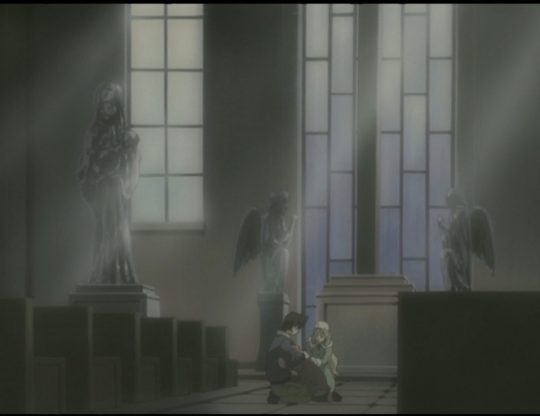
In the Paper Sisters’ family scenario, as it plays out in this episode, Anita is the Baby Jesus. Just so, it isn’t our shared worldview, culture, or identity that ties us together as Christians, or even our passion for God and his Word that keeps us together. Frankly, those things aren’t actually enough to prevent the schisms and splits and feuds that emerge in the church, which is why we struggle with unity and grace for one another. Neither doctrine, worldview, nor even good worship music is enough to bond us together through thick and thin. Instead, it is Jesus himself who unites us. So when we get distracted and we think that Family is about how we celebrate together or how we vote or how we make decisions and the opinions we hold about both worldly and church matters, it falls apart. But when we keep the one who brought us together in the first place front and center, it is much simpler to navigate the ups and downs of the miracle of life together.
So, maybe you don’t have a family to celebrate with this Christmas. Or maybe your family has a poor track record of being able to celebrate together in peace and with grace for one another. If that’s the case—and even if it isn’t—let’s all take a page out of the Paper Sisters’ book and ask God to continue to outwork that first Christmas miracle in our lives and hearts, and bind us to our Family through Jesus.
It may take time. In fact, it most likely will, because these kinds of miracles often do. There may be healing we need to go through, like Anita, as we learn to trust, or a courageous step we need to take, like Michelle and Maggie, in being willing to disrupt our daily lives. It may not be only up to us; our miracle may rely on someone else pitching in and partnering with God and with us too. Together, we may need to recenter our family lives—be it with our natural family or with our church family—on Jesus himself rather than on the other, more frangible ties that bind.
But the good news is that the necessary miracle is already in play! And God is inviting us to be a part of it, and to receive it, all at once.
Merry Christmas, everyone!
With love from the Beneath the Tangles family.
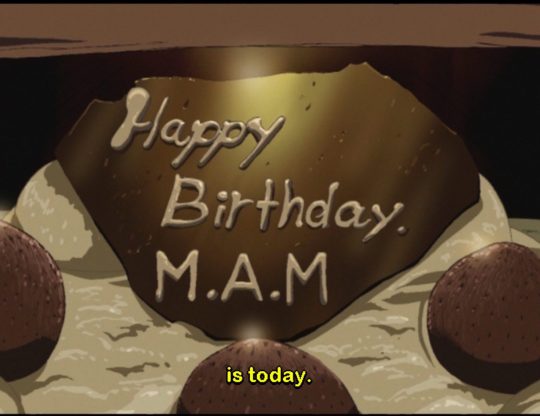
Michelle, Anita, Maggie—and Jesus too!
=====
R.O.D the TV isn’t streaming anywhere, but it can be purchased on DVD. Totally worth it too!
#Anime#Christianity#R.O.D. the TV#Christmas#Advent#Miracles#12 Days of Christmas Anime#Articles#Author: claire
0 notes
Photo



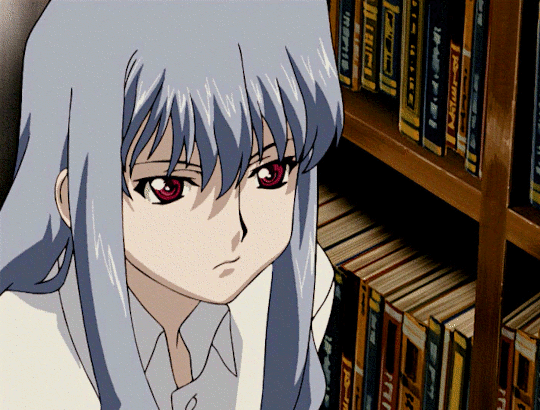
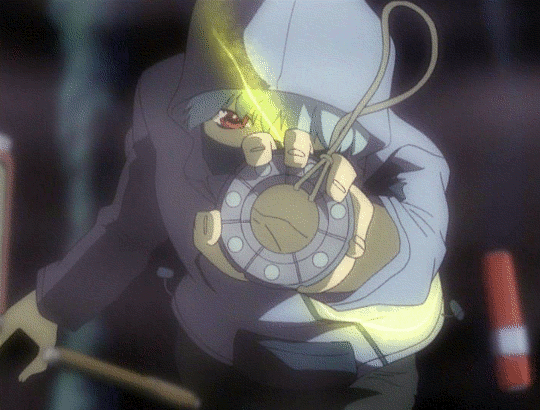



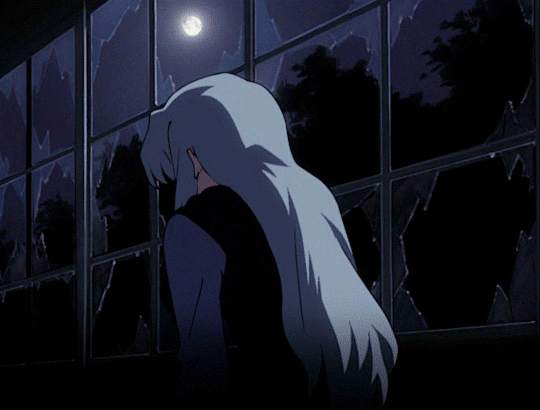


“So, I’ve been raised to be a container? What’s going to become of me then? What’s going to happen?”
Kick-Ass Characters: Junior in R.O.D -THE TV- (2003–2004) dir. Koji Masunari
#read or die#r.o.d#r.o.d the tv#animeedit#animationedit#oldanimeedit#dailyanimatedgifs#tvedit#junior#tv#animation#gifs#my edit#*mygifs#2000s#kickasschars#bonus gif for happy junior#cuz i need junior to be happy#made this especially to accumulate exactly zero notes#was debating about the YOU'RE NOT MY MOTHER scene#holy he was asking for that bitch slap#just realised junior was born in 2001 or '02#omg he's like 21!
94 notes
·
View notes
Text

#watched all of r.o.d the tv with my friend a little while ago and laughed really hard at this animation#maggienod.gif has been so very important to me ever since
2 notes
·
View notes
Text
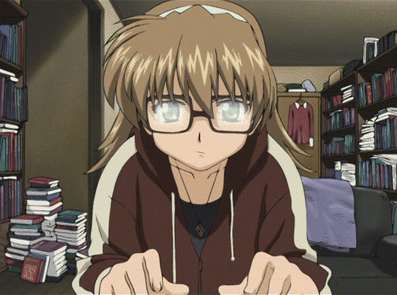
136 notes
·
View notes
Text
Gankutsuou and Read or Die were ahead of their time like ??? the soundtrack, the designs, the plot, everything. Go on youtube right now and search any of r.o.d the tv osts. They are BOMB.
18 notes
·
View notes
Text
Yuri Subtext (?) Anime List
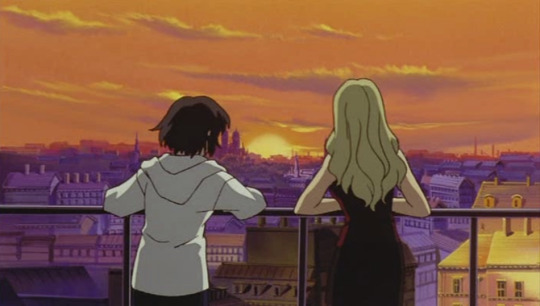
A supplement to my earlier yuri anime masterlist, this list covers anime which aren’t marketed as yuri but which prominently feature F/F pairs, whether canonical or subtext! Since subtext is so subjective, this post only includes series which I’ve actually watched, and so is by no means intended to be comprehensive.
Also, since the above description would not cover certain series with well-known yuri pairings, I've also included a few "bonus rounds" for the curious (although these are still limited to series I have watched).
At-a-glance list:
Revolutionary Girl Utena (39 episodes + 1 movie, 1997)
NOIR (26 episodes, 2001)
Puella Magi Madoka Magica (12 episodes, 2011)
Haibane Renmei (13 episodes, 2002)
.hack//SIGN (26 episodes, 2002)
Read or Die / R.O.D. the TV (26 episodes, 2003)
Mobile Suit Gundam: The Witch From Mercury (24 episodes, 2022)
Black Rock Shooter (8 episodes, 2010)
Izetta: The Last Witch (12 episodes, 2016)
Violet Evergarden: Eternity and the Auto Memory Doll (movie, 2019)
Canaan (13 episodes, 2009)
Ga-Rei: Zero (12 episodes, 2008)
Bonus rounds:
Sailor Moon S3 (38 episodes, 1994) (subtext)
Mai-Hime (26 episodes, 2004) (canon)
Psycho-Pass (41 episodes + 3 movies, 2012) (canon)
My Next Life as a Villainess: All Routes Lead to Doom! (24 episodes + movie, 2020) (canon)
Summaries under the cut!
1. Revolutionary Girl Utena (39 episodes + 1 movie, 1997) - Anime News Network | MyAnimeList

(Copied from the Yuri Anime Masterlist post, since technically it wasn’t marketed as yuri)
When she was a child, Tenjou Utena (Kawakami Tomoko) was saved by a passerby prince, so she decided that she too wanted to become a prince as an adult. Fast forward to high school, and she hasn’t forgotten that conviction: Utena gets sucked into a series of duels while trying to protect her best friend’s honour. After winning the first duel, she becomes ‘engaged’ to the eccentric “Rose Bride” Himemiya Anthy (Fuchizaki Yuriko), and the two start living together in the same dormitory.
First things first: there are a million content warnings for this series, including implied rape, sexual assault, incest, and homophobia. Although the issues are handled well (in my opinion), it does go to very dark places, so those wanting a light, fun anime to unwind to should look elsewhere. Second, this series is very much a psychological drama utilising the episodic duels as a way of hone in on Utena’s opponents and their stories, so Utena and Anthy’s relationship – though important – is definitely not the focus of the anime. Third, the TV series is limited to hinting at the romantic relationship between Utena and Anthy, not to mention that they spend most of the series being little more than acquaintances rather than actual friends. The movie Adolescence (which can be taken as a retelling or sequel, depending on your perspective) is much more explicit on this front, but also suffers from a significantly shorter runtime and a much more opaque approach to storytelling.
That being said! If you’re okay with all of the above, this series is pretty much essential. The simplistic premise belies a much more complex and nuanced story about gender roles, sexuality, and human relationships and remains one of the smartest anime ever made, over twenty years on.
2. NOIR (26 episodes, 2001) - Anime News Network | MyAnimeList
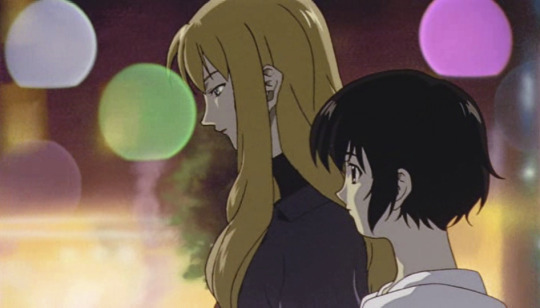
The first in anime studio Bee Train’s “girls with guns” trilogy, NOIR follows globetrotting assassin duo Mireille Bouquet (Mitsuishi Kotono) and Yuumura Kirika (Kuwashima Houko) as they partner up to search for Kirika’s missing memories and the truth behind Mireille’s parents’ deaths. The series is pleasingly restrained despite the sensational premise, alternating between “business trips” to far-flung locations and snapshots of the pair’s domestic life in Mireille’s Paris apartment, and devoting more time to the unfolding of the relationship between the prickly Mireille and puppy-like Kirika than to action sequences. I won't say too much due to spoilers, but their relationship numbers among my favorites due to how naturally it is developed throughout and how it is very much at the heart of the series both narratively and thematically.
This is also the first anime soundtrack entirely composed by the legendary Kajiura Yuki, heralding a long collaboration with director Mashimo Kouichi, and her mix of classical and modern sounds provides the perfect accompaniment to NOIR’s atmospheric cityscapes. Also, for fans of Mitsuishi’s work (Sailor Moon! Utena! Evangelion!), I’d say NOIR is a must-watch for her performance alone; her Mireille is brittle and proud, and she brings so much humanity and nuance to the role. In fact, I don’t care if you’re a fan of Mitsuishi or Kajiura or assassins or whatever, please just try the first episode— this anime deserves way more love!
3. Puella Magi Madoka Magica (12 episodes, 2011) - Anime News Network | MyAnimeList

Puella Magi Madoka Magica opens with ordinary middle school girl Kaname Madoka (Yuuki Aoi) standing in the ruins of her hometown, watching as a lone girl struggles to defend what remains of the city against a much more powerful enemy. A little rabbit-like creature informs Madoka that the girl is sure to lose without her help, and so Madoka decides to become a magical girl right then and there— at which point she wakes up and dismisses it as a strange nightmare. But then that very day, her school receives a new transfer student who looks just like that mysterious girl, and she also finds a hurt animal that closely resembles the rabbit-like creature from her dream. Madoka is then faced with certain questions: do magical girls actually exist, and will she become one herself?
Since Madoka Magica was all the rage back in the early 2010s, I don’t think it too much of a spoiler to say that the cheery first three episodes hide a dark, gritty story which uses the concept of magical girls to explore the tumultuousness of adolescence. The queer subtext only comes in at the end but tight plotting and inventive presentation make this show a quick watch— and if you’re the type who likes queerness in fiction to be intense, world-shakingly significant, and a wee bit problematic, the payoff should be more than enough. A word of warning: there is a movie sequel called Rebellion, but if you’re happy with the ending of the anime, it’s best not to watch it (although I love the movie, myself).
Side note: I won’t go into it too much due to spoilers but if you liked Madoka Magica you might want to check out Serial Experiments Lain – even if most of it is utterly incomprehensible (as it was to me), it’s worth watching until the very end (wink). Also, for the rare fan of Rebellion, Adolescence of Utena is a must-watch if you haven’t checked it out already; so much can be said about its conceptual and aesthetic influences on Rebellion!
4. Haibane Renmei (13 episodes, 2002) - Anime News Network | MyAnimeList

(Note: slight spoilers about the tone and overall themes of the show – but I think it’s necessary for the purpose of writing a more representative summary.)
Written by ABe Yoshitoshi – character designer of cult classic anime Serial Experiments Lain and author of the very unfinished manga which this show adapts and significantly develops – Haibane Renmei starts off as a light-fantasy slice-of-life anime following freshly-arrived Rakka (Hirohashi Ryou) as she searches for a suitable job in the town of Glie, before transforming into a nuanced exploration of grief and depression about halfway through. To say more would be really too spoilery, but I just want to say that this has probably the most grounded and sensitive depiction of depression I have seen in an anime; it shows that sometimes people struggle even if everyone around them is kind and supportive, but remains hopeful about the healing power of time and understanding. The subtext is between the protagonist and Reki (Noda Junko), the first person she meets, who also helps her get acclimatised to her new life in Glie. Again, I won’t say more, but their relationship really is wonderful. That being said, this show does touch upon suicide and suicidal ideation in the course of discussing these themes, so please steer clear if that is something you are wary of.
5. .hack//SIGN (26 episodes, 2002) - Anime News Network | MyAnimeList

A standalone spinoff of the .hack PS2 games, this show was the most well-known anime about players getting trapped inside a multiplayer game before Sword Art Online’s arrival in 2012 (ironically, Kajiura Yuki composed the music for both). Rather than being an action-adventure story about a heroic protagonist trying to find a way back to the real world, SIGN stands out as an introspective piece, far more interested in the psychology of those who play online games and the issues of human connection and identity. In fact, the female protagonist is all too happy to remain within the MMORPG as male player-avatar Tsukasa (Saiga Mitsuki) after becoming unable to log out; the story is more about how the player grows to accept the real world with the help of the other players she meets, rather than about figuring out the exit route.
On the F/F side, some way into the series, Tsukasa makes an instant connection with fellow player-character Subaru (Nazuka Kaori) and they soon start spending a lot of time together. I really love their scenes together; the series' masterful use of body language, framing, and music all comes together to create these beautifully tender moments of intimacy. Although there’s no kiss scene nor explicit discussion of dating etc., a lot of the other characters talk about their relationship and perceive it as being romantic, to the point where one gets homophobically “worried” about Subaru when they find out that the player controlling male avatar Tsukasa is female. Tsukasa and Subaru's relationship becomes a lynchpin for both characters' development, and in general is used to illustrate the series' underlying themes in a thoughtful and heartwarming way.
6. Read or Die / R.O.D. the TV (26 episodes, 2003) Anime News Network | MyAnimeList

A spinoff of the Read or Die series which takes more from espionage thrillers and Hong Kong action flicks than shounen anime, R.O.D. the TV takes the unusual approach of starting with its main character - elite paper-maniuplating superspy Yomiko Readman (Miura Rieko) - being nowhere to be seen after burning down the British Library in a dramatic resignation announcement. Instead of focusing on her, or the spy agencies clashing in her absence, the story instead follows her friend Sumiregawa Nenene (Yukino Satsuki), who joins up with a trio of sisters with paper-manipulating powers and criminal connections in her quest to find out what happened to Yomiko. The queerness is mainly implied through Nenene's focus on Yomiko, which is unrequited and sadly fizzles out narratively speaking in the back half. Unfortunately, this is coupled with an increased focus on more heteronormative topics, such as Yomiko's grief over her dead male lover, and the child one of the characters had with the villain of the OVA. That being said, I also want to shout out this series' surprisingly earnest depiction of budding queerness in a young (like, elementary-school young) side character - something that is rare in fiction even now.
7. Mobile Suit Gundam: The Witch from Mercury (24 episodes, 2022) - Anime News Network | MyAnimeList

The most recent entry on this list by far (the final episode aired just a day ago at time of writing), The Witch from Mercury initially seems to forgo the Gundam franchise’s usual grand scale, being set in an academy run by the corporate giant Benerit Group. Main character and new student Suletta Mercury (Ichinose Kana) - the franchise’s first female protagonist since its beginnings in 1979 - accidentally bumbles her way into fighting a mecha duel, and, when she wins, is shocked to find that she is now engaged to the sole heiress of that self-same corporate giant, her classmate Miorine Rembran (Lynn). So far so Utena, but after the first episode, things start to diverge significantly: though the duels continue, the focus shifts to how big-picture tensions such as the manoeuvring within the Benerit Group and the conflict between the space colonisers and people on Earth play out within the student body, and how the arrival of Suletta and her mysteriously cutting-edge mecha start to shake up the status quo… until things come to an explosive head.
For those who curious about G-Witch due to Suletta and Miorine, but who wouldn’t normally be interested in Gundam or space operas, I’ll just say that if the hype has led you to expect a big queer romance where Suletta and Miorine shout their love from the rooftops, well, that’s not how it goes. It’s a mecha anime first and foremost, after all! But lower your expectations and you may be pleasantly surprised. Season 1 offers plenty to enjoy in terms of Suletta’s earnest attempts to be a good “bridegroom” and the tsundere Miorine’s bouts of jealousy over Suletta. And while their relationship takes a bit of a back seat in Season 2 due to there being So Much going on, it remains one of the key elements of the series and their scenes together are the emotional peaks of the season.
Side note: Some might criticise Gundam for taking so long to have a female main character, but let’s not forget about how the even older Ultraman (1966), Kamen Rider (1971), and Super Sentai (1975) franchises still have not had a single mainline series featuring a female protagonist… Come on guys, I’m dying for a female-led Kamen Rider over here!
8. Black Rock Shooter (8 episodes, 2010) - Anime News Network | MyAnimeList

One of the two anime inspired by the Hatsune Miku song of the same name, this Okada Mari-penned series hones in on the passionate friendships and jealousies of a group of middle-school girls. In a twist that feels informed by the psychological allegory of the popular Persona games, this interpersonal drama plays out in the surreal battle world of the music video, with the titular Black Rock Shooter being the main character’s alter-ego. Of particular interest is the first half’s focus on the blossoming friendship between protagonist Kuroi Mato (Hanazawa Kana) and her shy classmate Takanashi Yomi (Sawashiro Miyuki), which has strong overtones of two girls developing crushes on each other – it doesn’t go smoothly, but hey, that’s life.
9. Izetta: The Last Witch (12 episodes, 2016) - Anime News Network | MyAnimeList
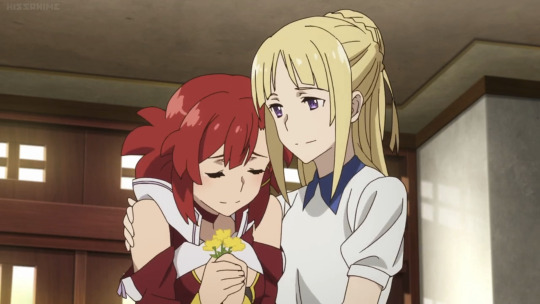
Set during what is basically World War 2, Izetta: The Last Witch asks the daring question of “What if a small European country about to be invaded by alternate-history Nazi Germany could fight back with magic… and what if it was (subtextually) yuri?” The show follows politically-minded princess Finé as she and her best friend (read: girlfriend) Izetta think up ways to leverage the latter’s witchy gifts to save the country from invasion – a rare case of a military anime where female characters are significantly involved at the strategic stage. Those who enjoy the classic princess-and-knight trope may find something to like as long as they are fine with Finé and Izetta not having much relationship development (as their dynamic is established from the start) and them not having many one-on-one scenes together (as the series’ main focus is on the political manoeuvring). Note that this show is also pretty heavy on the fanservice – IIRC there was at least one moment of egregious sexualisation per episode.
Side note: those who like Izetta may also want to check out Last Exile: Fam, the Silver Wing, a female-focused dieselpunk anime with a lot of military strategizing and a very cool world setting, though Izetta is better-paced and the main relationship is much more plot-significant. (That being said I do like the relationship between Fam side characters Tatiana and Alistair… Tatiana is probably the adult character with the most screentime in Fam, being the main characters’ commanding officer, and although it’s very background, she has this cutely settled dynamic with former piloting partner turned wife right-hand woman Alistair.)
10. Violet Evergarden: Eternity and the Auto Memory Doll (movie, 2019) - Anime News Network | MyAnimeList

(Note: this entry’s a slightly weird one, it only covers the first 40 minutes of this movie due to it being basically two episodic stories smushed together into a single package, and only the earlier story is relevant to this list.)
In this standalone spinoff of the Violet Evergarden anime series – itself an adaptation of the light novel series by Akatsuki Kana – the titular protagonist Violet (Ishikawa Yui) takes a break from ghostwriting letters to serve as companion to aloof young noblewoman Isabella York (Kotobuki Minako) in her last months of finishing school. The story is a quiet coming-of-age tale focusing on how the kind (and rather dashing!) Violet helps Isabella to open up, or, in simpler terms, it’s fodder for butler-and-lady fans. Don’t get your hopes up too much, though: Violet learning about her romantic feelings for her deceased male superior is one of the main throughlines of the anime, and this (half of the) movie also ends with a heterosexual arranged marriage for Isabella. That being said, this movie is really a feast for the eyes, its historical-fantasy setting being brought out with beautiful backgrounds and detailed linework, so it’s worth checking out if you don’t mind the very Class S narrative.
Side note: if you want F/F butler-and-lady or princess-and-knight vibes I would really recommend watching Fate/Zero for Saber and Irisviel – yes Irisviel is already married to one of the (male) main characters and yes Saber is absolutely the main love interest for the famously-straight Fate/stay night, but their dynamic is really good and Saber gets to wear a stylish suit and be all chivalrous to a woman… Please watch the third episode of season 1 at least…
11. Canaan (13 episodes, 2009) - Anime News Network | MyAnimeList
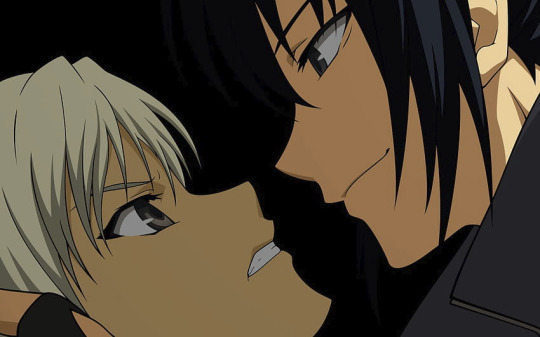
There’s quite a lot going on in Canaan – perhaps unsurprisingly so for a spinoff of the FMV visual novel 428: Shibuya Scramble, which is famous for its intertwined storylines – but in true action-movie blockbuster style, all you really need to know is that the titular mercenary Canaan (Sawashiro Miyuki) is on a hunt for her mentor’s protégé-turned-murderer, and a lot of flashy fighting is involved. Also, there's no need to worry if you haven't played the original game, as Canaan is pretty much a standalone work and all of the significant characters are original to the anime. Yuri-minded viewers may enjoy her clashes with the villain Alphard (Sakamoto Maaya), but the main source of F/F subtext is her relationship with the young photographer Maria (Nanjo Yoshino), for whom she cares deeply and must rescue on multiple occasions. However, do be warned that the one canonically queer character in the show – Alphard’s subordinate Liang Qi (Tanaka Rie), who is fixated on her boss – is handled very badly, being portrayed as a raving predatory lesbian who is mocked, rejected, and finally killed by the object of her affections. Canaan and Maria’s relationship is also framed very definitively as friendship by the end of the series, although they don’t get paired off with male characters. IIRC there’s also some fanservice but I can’t remember the details as it was a long time ago, sorry.
12. Ga-Rei: Zero (12 episodes, 2008) - Anime News Network | MyAnimeList

Back in the old days, I had heard this show talked about in the same breath as yuri classics such as Kannazuki no Miko and Mai-Hime, and, well, like those series it comes with significant caveats (though thankfully there is no sexual assault). Although it’s a prequel to the Ga-Rei manga by Segawa Hajime, the anime is basically standalone and focuses on original characters Kagura (Chihara Minori) and Yomi (Mizuhara Kaoru), the latter of whom welcomes protagonist Kagura into her family and demon-hunting squad, only to leave the team in a devastating betrayal. After the explosive opening, the series jumps back to explore the events leading up to that point; fans of director Aoki Ei’s work on Fate/Zero should note that the dark tone disappears in the third episode and never quite comes back even when things get serious. Viewers should also keep their F/F expectations in check, since despite the premise I would say the series is more plot- than character-focused, and on top of that a significant amount of time is devoted to Yomi’s relationship with her male fiancé (Yomi and Kagura have more screentime together, but there’s not much development whereas Yomi and her fiancé are given a whole romantic arc). There is one very fanservicey scene between Kagura and Yomi in a car early on (in episode 3?) which viewers may want to skip, but IIRC it’s an outlier and the rest of the series is nowhere near as bad.
Bonus Rounds
1. Sailor Moon S / Season 3 (38 episodes, 1994) (subtext) - Anime News Network | MyAnimeList
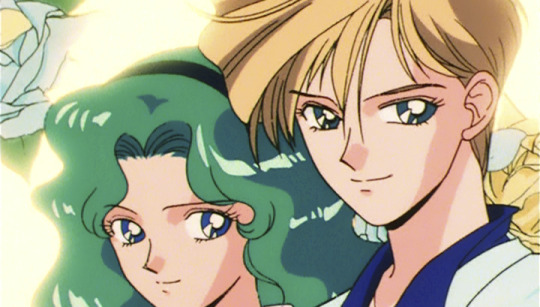
Possibly the most widely-known F/F couple in anime, Haruka and Michiru (Ogata Megumi and Katsuki Masako, respectively), make their first appearance in episode 3 of the third season as mysterious newcomers who refuse to work alongside the Sailor Senshi. Apart from being consistently framed as an ideal couple throughout (they practically cruise to victory in a couple’s contest in episode 5 of S3), they also get some juicy narrative moments, being the main subject of the excellent episodes 17 and 21 – the latter being the mid-season climax. They return in S5 but I haven’t watched that season yet.
Side note: Utena fans may be particularly interested to hear that the aforementioned Haruka-and-Michiru-centric episodes 17 and 21 are helmed by key Utena creatives. Both were written by Enokido Yoji, Utena's lead scriptwriter, while episode 17 was directed by Igarashi Takuya (who storyboarded 5 Utena episodes) and episode 21 was directed by Utena director Ikuhara Kunihiko himself.
2. Mai-Hime (26 episodes, 2004) (canon) - Anime News Network | MyAnimeList
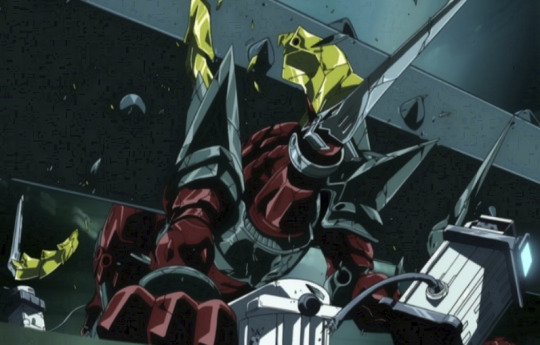
Way back when, Mai-Hime was very popular among yuri fans for including a canonically queer female character who was in love with another female character… even though, like in Kannazuki no Miko which was broadcast the same year, she commits sexual assault against her. For those still curious, Mai-Hime starts out as a quirky fighting-monsters-and-going to school anime but turns into a battle royale where characters fight each other using robots – the twist being that the robots symbolise their love for the person most precious to them, and if destroyed, that person will die. The queer storyline comes in only in the last quarter or so, but is compellingly told and at least the queer character isn’t quite as maniacal or otherwise demonised compared to some others (looking at you, Liang Qi in Canaan). It's a fun reveal, so I won't spoil it here even if you're likely to have heard of it already.
3. Psycho-Pass (41 episodes + 3 movies, 2012) (canon) - Anime News Network | MyAnimeList

Psycho-Pass is set in a dystopian world where people are rated on their criminal tendencies; the main characters’ job as police officers is to arrest those whose tendencies exceed a certain level. The F/F is canon but very, very background; one of the surprise twists of the finale is that forensics expert Karanomori Shion (Sawashiro Miyuki), whose appearance screams “sexy doctor character” but is played with surprising warmth by Sawashiro, is actually in a relationship with seemingly aloof field officer Kunizuka Yayoi (Itou Shizuka). I only watched the first season and so can’t comment on the rest, but apparently they are still in a relationship in the third season.
4. My Next Life as a Villainess: All Routes Lead to Doom! (24 episodes + movie, 2020) (canon) - Anime News Network | MyAnimeList

An adaptation of Yamaguchi Satoru’s popular light novel series, this show headed the wave of reincarnated-villainess isekai, focusing on the bumbling Catarina Claes (Uchida Maaya) – in actuality an otaku who has been reincarnated into an otome game – as she tries desperately to remove her character’s image as a villainess and thereby inadvertently attracts the attentions of many a suitor. Among this reverse harem are three female characters Maria Campbell (Hayami Saori), Mary Hunt (Okasaki Miho), and Sophia Ascart (Minase Inori).
While the female suitors’ romantic interest in Catarina is generally not undermined or played as a joke, they are not necessarily treated as equally valid options compared to the male suitors - it doesn't feel like Catarina has a real chance of ending up with any of the female characters. I've heard this starts becoming more obvious in S2 (which I haven't watched), which apparently focuses on Catarina's relationship development with one particular male suitor compared to the others. Also, the VN spinoff had 6 routes in total (all 4 male suitors + 2 original male characters) but did not include a single female route, despite being non-canon in nature.
#yuri#yuri anime#lesbian#revolutionary girl utena#g witch#puella magi madoka magica#sailor moon#violet evergarden#black rock shooter#psycho pass#my next life as a villainess#haibane renmei#noir anime#read or die#shuumatsu no izetta#canaan anime#ga rei zero#mai hime#dot hack#.hack//sign#wlw media#wlw anime#list#fate zero#last exile#wlw recommendations
481 notes
·
View notes
Text
youtube
THE PILE PRESENTS: AOTS! - Commencing in T-Minus Right Now | 4/7/05
How very Devious.
(4GTV - STREAM WHAT YOU PLAY! WATCH NOW!)
#The Pile#G4#Attack of the Show!#Xbox 360#Call of Duty#XFire#AOL#NASA#World of Warcraft#Sony#DeviantArt#anime unleashed#R.O.D. the TV#Formula D#Street Fury#G-Spot#T-Mobile#AXE#Twix#Netscape#Exorcist: The Beginning#NARC#The Amityville Horror#Jade Empire#Butterfinger#Saw#Mortal Kombat#TAG#Doritos#Midnight Club 3: DUB Edition
1 note
·
View note
Note
Goddammit read or die looks like a good time. Where can I go watch it?
There’s a TV series which I didn’t super enjoy
But what I’m blogging about is the OVA, which is currently out of print and so the only viable way to watch it is on the internet archive!
Enjoy!
EDIT: Oh no wait. I’m not sure this version has English subs!!!!!!! Or even the dub which was quite good. I’ll keep searching!
42 notes
·
View notes
Text
Notable And Underrated Anime That Have Excellent English Dubs, In My Opinion - A List (With Some Extra Banter or Whatever)
The works of Shinichirō Watanabe, ranging from Cowboy Bebop, Samurai Champloo, Space Dandy, and Carole & Tuesday (so much so that they're better off disqualified from lists likes this, due to being way too obvious choices... moving on)
FLCL (heck, would even say the same to the otherwise derivative Progressive and Alternative)
The Read or Die OVA, alongside its sequel series R.O.D the TV (so good, that even the likes of Yomiko "The Paper" Readman changing accents actually doesn't feel as jarring as I thought it would be)
Azumanga Daioh (on a side note, Ayumu "Osaka" Kasuga sounds a bit like Steven Universe's Amethyst and The Owl House's Vee Noceda; can't really say why)
Lucky Star (so, which part of the Choco cornets should we eat first?)
Nichijou ('nuff said)
K-On!/K-On!! (might sound a bit jarring if one also watched Puella Magi Madoka Magica on the English dub (a bit good, but nothing compared to the Rebellion movie and maybe the compilation films; case in point, Mio Akiyama, Ritsu Tainaka, Tsumugi Kotobuki, and Azusa Nakano are Homura Akemi, Kyubey, -bloody- Hitomi Shizuki, and Madoka Kaname respectively)
Tengen Toppa Gurren Lagaan (kinda sucks that the two compilation movies don't have dubs; would have loved seeing the extra hamminess of the characters' English voices in those)
Nadia: The Secret of Blue Water - ADV (even if the occasional accents are inaccurate, the emotional delivery of the VAs is hard to deny, especially the vile Gargoyle's)
Kill la Kill (if one has witnessed it, then you know that they sure had a lot of fun playing the characters in this extremely fun gainaxy romp)
Toradora! (...basically the closest we get to seeing Madoka verbally beat down Kyubey in romance and stuff)
Ghost in the Shell, both the movie duology (1 and 2: Innocence) and Stand Alone Complex, including the Tachikomatic Days extras and the Solid State Society movie (so much so that the latter's DVDs are mostly set with the English dub on default, reportedly even in Japan)
REDLINE (can't speak enough for it so to describe its epicness)
Dead Leaves (you can actually watch it on YouTube... it might overwhelm you)
Panty and Stocking with Garterbelt (telling that it's way more raunchy than even the original Japanese)
Golden Boy (you know, at least the show didn't continue on, lest it might have gotten way too weirder like the manga it's adapted from)
Black Lagoon (so good, that it resulted with the Roberta's Blood Trail OVAs having the cast reprise their roles due to fan demand)
Excel Saga and Puni Puni Poemy (so madcap, the former's titular character's VA broke her voice halfway through the show)
Honorable mentions:
Neon Genesis Evangelion - particularly the ADV dub, with Manga Entertainment's efforts on The End of Evangelion and the Director's Cut versions of Episodes 21-24 (it might be correctly deemed as flawed, but nowadays, it sure has proven its worth, albeit at the cost of the Netflix dub being derided as lacking in emotion and perhaps also nuance)
The Manga Entertainment dubs for the Patlabor movie duology (a shame the OVA series preceding it doesn't share the same cast, while the Patlabor TV series dub... eludes me)
GaoGaiGar (flaw: it's unfinished, and thus never even reached the FINAL parts)
In the meantime, hopeful readers, feel free to put on personal recommendations, in case there'll be a second part, if not a commenter's edition.
#anime#shinichirō watanabe#cowboy bebop#samurai champloo#space dandy#carole and tuesday#flcl anime#read or die#azumanga daioh#lucky star#k on#tengen toppa gurren lagaan#nadia the secret of blue water#kill la kill#toradora#ghost in the shell#redline#dead leaves#panty and stocking with garterbelt#golden boy#black lagoon#excel saga#puni puni poemy#honorable mentions#neon genesis evangelion#patlabor#gaogaigar#random posts#tumblr#reading lists
72 notes
·
View notes